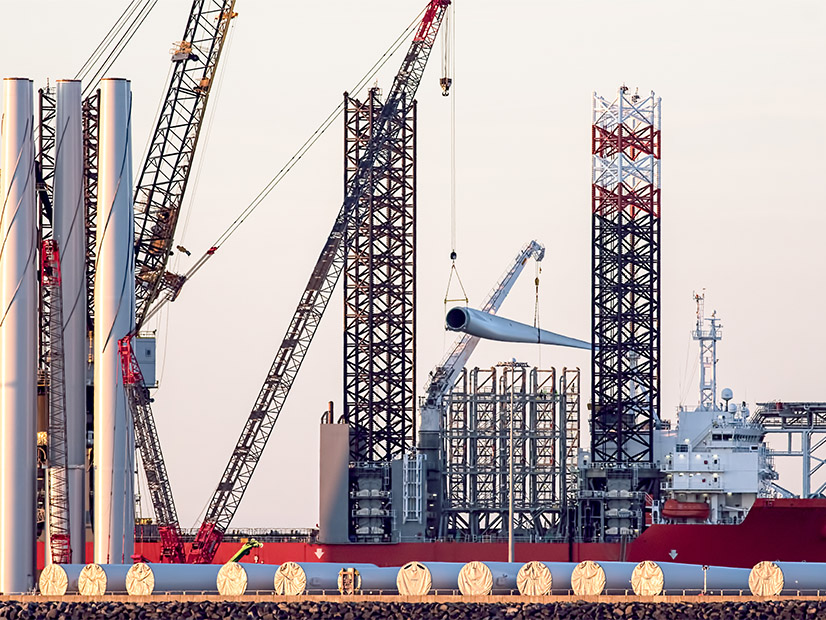
A report issued Monday lays out a path for the U.S. to follow as it builds a network of offshore wind turbines and presents it as an opportunity to create an entirely new industry.
The National Renewable Energy Laboratory on Monday announced “A Supply Chain Road Map for Offshore Wind Energy in the United States,” which estimates President Biden’s goal of 30 GW installed capacity by 2030 could create tens of thousands of new jobs.
But there is some urgency to the effort, the report says, as there is limited infrastructure and manufacturing capacity now, and building it will take years. Given the extended lead time involved, most resources would have to be committed by the end of 2023 to create an operational supply chain by 2030.
The vessels and port infrastructure that exist now or are planned to be built would be enough to install only 14 GW by 2030, for example. And components for up to 83% of that first 30 GW of wind equipment would still need to be imported, while factories are being set up in the U.S. and American workers trained to run them, the report says.
“A manufacturing supply chain is already emerging in more than a dozen locations up and down the U.S. coast in support of the offshore wind industry, which will lead to thousands of well-paying jobs,” said Ross Gould of the Business Network for Offshore Wind, part of the partnership behind the report.
“To meet our ambitious clean energy national goals,” he said in a news release, “American manufacturers must play a larger role to accelerate our transition. This road map lays out the challenges and collaborative actions needed to bring more domestic companies into the supply chain and the opportunity those businesses bring to building out the U.S. offshore wind industry.”
Offshore wind has been gaining momentum for several years, with multiple states pressing development of multiple projects, particularly along the Northeast and Mid-Atlantic coasts.
The report’s authors say there is a widespread agreement that a domestic supply chain will be critical for sustainable growth in the new industry, but no clear understanding of what the supply chain should look like, how long it will take to create, what costs it will extract, what benefits it will yield and how much the existing infrastructure will accomplish.
“We demonstrate that if individual states leverage their existing manufacturing capabilities to contribute to the offshore wind energy sector, this conceptual supply chain would generate significant workforce and economic benefits throughout the United States, not just in coastal locations with active offshore wind energy programs,” the report states.
Multiple potential roadblocks were found on the road map, including communication gaps between stakeholder groups; scarcity of space and uncertainty of permitting for manufacturing facilities in ports; stress on supply networks for raw materials and subcomponents; and insufficient incentives for incorporating equity and sustainability into supply chain decision making.
But the most common concern that manufacturers shared with the report’s authors was the difficulty in securing financing to build the components of a supply chain because of perceived risk of cost or schedule overruns, legal challenges, and changes in government policy.
The report did not even look at the complexity of the transmission grid expansions that would be needed.
Details
The project is being overseen by the National Offshore Wind Research and Development Consortium and conducted by the National Renewable Energy Laboratory, the Business Network for Offshore Wind and DNV Energy USA.
A full project summary will be released by NOWRDC late this winter.
Monday’s report quantifies the resources needed to build a supply chain to reach the 30-GW goal by 2030 as follows:
- $22.4 billion minimum initial investment
- 12,300 to 49,000 full-time equivalent workers
- 6,800 miles of cable
- 2,100 turbines
- 2,100 foundations
- 58 crew transfer vessels
- 34 new manufacturing facilities
- 11 service operation vessels
- 8 East Coast marshaling ports
- 4 to 8 transport vessels
- 4 to 6 heavy lift vessels
- 4 cable lay vessels
- 2 floating wind integration ports
- 2 scour protection installation vessels
Recommended near-term actions (2023-2024) to build a foundation are:
- Convene working groups focused on local and holistic aspects of the supply chain.
- Identify efficient and equitable locations for infrastructure.
- Assess the need for additional incentive mechanisms.
- Establish mechanisms targeted at floating wind infrastructure.
- Establish curriculum and funding streams for workforce training centers.
- Increase supplier awareness of offshore wind energy opportunities.
Recommended middle-term actions (2025-2030) to gain momentum are:
- Construct the major supply chain facilities to meet demand.
- Develop and share supply chain best practices.
- Incorporate lessons from early OSW projects into operations and decision-making.
- Train a manufacturing workforce.
- Evaluate procedural and impact equity metrics for early OSW projects and incorporate best-practices into ongoing supply chain development activities.
Recommended longer-term actions (beyond 2030) to maintain a stable industry are:
- Update key supply chain infrastructure to adapt to evolving technologies.
- Expand supply chain infrastructure to new regions using lessons learned in early projects.
- Add domestic production to fill manufacturing gaps in supply chains.
- Continue to expand the offshore wind energy pipeline toward a potential 2050 goal of 110 GW installed capacity.



